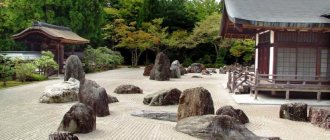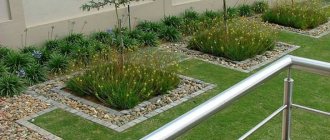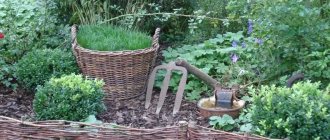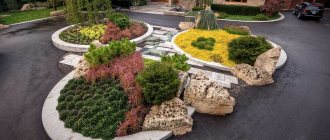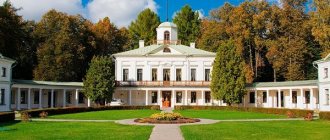It represents nothing more than a person’s desire to streamline and organize everything rationally. Most often, compositions built on a site in a regular style resemble a strict and consistent conservative ornament, in which one part is a reflection of the other according to the rule of symmetry. Here the main concepts are rigor and refinement of appearance, as well as some orderliness, which is achieved through symmetry. Symmetry can be made from the house (where the building is the reference point) or from another design element, where it will be taken as 0. Here, the ground floor can also be taken as the reference point in the center, that is, from French, an element close to the ground . It could be anything, for example, a flower bed, a fountain, a pond, or just a lawn. The person decides here.
Nowadays, it is extremely difficult to find a clean, regular style. As a rule, the formal style is used to decorate a separate section of the garden or they borrow only the brightest and most interesting elements from it, harmoniously fitting them into gardens of other styles. This is due not only to fashion, but primarily to the labor-intensive and costly process of creating a regular garden. The formal style is a celebration of wealth, perfection and grandeur, which is inherent in classical architecture, so it will be the best decoration for mansions built in antique style, with balustrades, terraces, and rich sculptural elements. In the symmetrical layout of regular gardens, the correct proportions and shapes of majestic ancient buildings are clearly visible.
Layout
The French, or regular, style is characterized by neat, strictly symmetrical compositions made in the form of various geometric shapes. Moreover, both in the basic construction and in the details there is a law that determines the order and power of man over the wild surrounding nature. Most compositions are created over large areas and in one plane. This technique, called “parterre,” implies a quadrangular lawn, in the center of which there is a flower bed, a small pool with a fountain or a sculpture with branching paths. The ground floor is surrounded by a border of neatly trimmed evergreens such as cypress, conical spruce, pyramidal poplar and other low-growing trees with a dense geometric crown.

The ideas of pomp, grandeur and formality characteristic of the French style require a visual expansion of space, which is achieved through flat terrain and a system of long and wide paths and alleys, decorated on both sides with ornamental shrubs. Alleys paved with broken bricks or river pebbles can run parallel to each other or intersect, but must necessarily converge at the house as the central object of the composition. The French garden has two key points - the upper one, where the house is located, and the lower one with the main entrance. This arrangement is not accidental. In the old days, it was created in order to amaze guests with the pomp and grandeur of the entire composition. Along with pomp and theatricality, the French style is characterized by rationality and clarity of lines, therefore a clearly defined main axis divides the space into two absolutely symmetrical parts, the elements of which are subordinated to strict and precise forms.

One of the interesting elements is the labyrinths, which are thickets of juniper, honeysuckle or hazel with paths stretching over a large area. Shrubs for labyrinths require a mandatory geometric pruning. However, all the shrubs, trees and ponds of the French garden are distinguished by their strict geometric shape. A decorative pond with fountains and water cascades or an antique sculpture located in the center of the garden looks very elegant and stylish.
A distinctive feature of landscape design in the French style is the bosquet. This is a closed space with a geometrically regular shape. On all sides the bosquet is bordered by evenly trimmed and frequently planted acacia, hawthorn, Tatarian maple, spruce or currant trees. The interior space, called the green room or office, is decorated with a lawn or densely planted perennial plants. Between the bosquets there are neat paths covered with small granite or river pebbles.
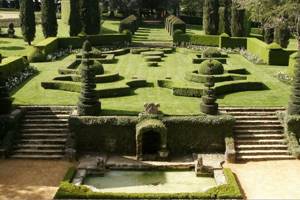
Most often, the panorama of a French garden unfolds in one landscape plane. For landscapes with differences in elevation, level areas with spacious terraces are created, which are connected by stairs. To add truly French charm, terraces can be decorated with parterres and bosquets. The fencing for a French garden can be a hedge in which there are special niches with garden furniture in light colors. In the far part of the garden, in the place where the ground floor with intersecting paths is located, it would be nice to install an elegant and cozy gazebo designed for relaxation.
Using a French garden layout would be appropriate if a country cottage or mansion is intended to receive such guests who need to be amazed by elegance, prosperity and a sense of taste. However, it must be taken into account that creating a park or garden in a formal style requires a fairly large space, a poorly defined terrain and the continuous work of a professional gardener to plant and improve it. A park or garden made in the French style has, first of all, the main axis of the entire architectural layout, and the arrangement of elements must be symmetrical. This will be the main idea of the style. The main entrance to such a garden should be located in the lower part, so that right from the entrance one can appreciate all the greatness and superiority of the composition.
In the usual layout, a park or garden is laid out in front of the building's facade, in the center of which, as a rule, there is a fountain or sculpture. This arrangement very advantageously emphasizes the perspective of the space, visually enlarging it. It is best if the plants that predominate are those that retain their shape for a long time and are easy to trim. They can be either coniferous or deciduous. In Belarus, plants such as spruce, thuja, hawthorn, spirea, maple, apple, plum, linden, barberry, privet, and cotoneaster are best suited for this purpose. Alleys of these trees and shrubs should be wide, spacious and always straight. The central alley, leading directly to the mansion, is planted with one type of tree. The remaining alleys, coming from the central one, can intersect at right angles, or diverge from the main alley in rays. All trees, shrubs, flower beds and lawns, in order to maintain their geometric shape, must be trimmed promptly and regularly, which requires time and effort, and in the absence of such, significant financial costs, which once again emphasizes the wealth of the owner. If the area of the park allows, then a “green labyrinth”, which usually consists of bushes and paths, can become a very interesting element of the French style. To create such a labyrinth, it is convenient to use juniper or honeysuckle, and line the paths with small pebbles or crushed bricks.
This style does not require a fence for a park or garden. Previously, ditches with water were used as fencing, which did not visually limit the space. They have been replaced by elegant wrought-iron trellises or hedges, in special niches of which garden furniture in pastel colors looks very beautiful. The part of the park located behind the mansion is usually designed in a free style. It is very convenient to place a beautiful, cozy gazebo for relaxation here.
In order for a regular style garden to retain its attractiveness for a long time, constant and careful care is required. Most often, this style is used to decorate government residences, government buildings, hotels, theaters and museums. In addition to public institutions, the French style can be used for landscaping country houses, driveways and pedestrian paths. In order not to disturb the harmony and the basic idea inherent in this style, it is necessary to preserve its traditions and, when designing, take into account the correspondence of the architectural style to the residential building.
What defines each style: comparing features
Any little thing can become the starting point when creating the landscape of your own hacienda. The main thing is to correctly classify it and determine its style. The love for the sandy shades of travertine can prompt the design of a garden “a la Italy”, the opinion that “the rose is the most beautiful of flowers” will suggest the use of English classics, the obligatory presence of the aroma of lavender is a direct reference to sun-saturated Provence. The main characteristics of the garden layout and filling elements will help you narrow the scope when choosing a style.
The following are distinguished by their rigor and the use of rectangular shapes when laying out a garden:
- Regular (French);
- Japanese;
- Mauritanian.
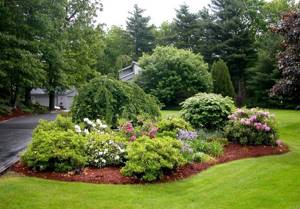
Smoothness and roundness of lines are inherent in:
- English style;
- Country;
- Russian Art Nouveau;
- Chinese;
- Ecostyle.
The lushness of flowering vegetation, a riot of colors within a geometrically rigid layout are characteristic of a Moorish garden space; a classic English garden, on the contrary, implies an ideally calibrated range of colors in cool shades, a large amount of greenery, and general coloristic restraint.
Choosing plants in a formal garden
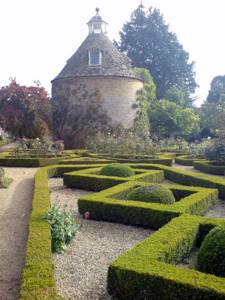
First of all, these are evergreen species that can look well-groomed and attractive throughout the year. In gardens of the French regular style you can often see monogardens - areas in which plants of the same species are cultivated, which determines the name of the monogarden: it can be a rose garden, an iridiary, a sirengarium, etc. It is impossible to imagine a “French garden without topiaries - figuredly trimmed trees and shrubs. Also obligatory elements for it are parterre lawns and parterre flower beds or, as they are also called, arabesque flower beds.
To form smooth and neat borders, yew and boxwood are usually used. Boxwood is easy to trim and is capable of maintaining even the most bizarre shapes for a long time. Yews are famous for their exceptional longevity, have dense crowns with whorled branches, love moist air, good sunlight and fresh soil saturated with lime.
Of the shrubs, first of all you should pay attention to privet, which is represented by both deciduous and evergreen shrubs. As a rule, they are sun-loving, grow well on ordinary garden soil, perhaps even with the addition of lime, but have difficulty withstanding wet, heavy clay with an acidic reaction. In French regular style gardens, it is preferable to plant common privet - a deciduous, densely branched shrub up to 5 m high, growing quickly and able to withstand temperatures down to -30°C in winter.

The second place in popularity among plants for gardens of the French regular style, adapted to Belarusian realities, is occupied by small-leaved linden (or cordate linden) - the most resilient representative of broad-leaved species. This plant can tolerate frosts down to -48°C in winter. The maximum possible growth level for the small-flowered linden is 30 m. It has a compact oval crown and a slender cylindrical trunk. Linden is shade-tolerant, not too demanding on soil quality, but does not tolerate drought. It grows relatively quickly and is ideal for forming a hedge.
Non-thorny shrubs such as cotoneaster would also look quite appropriate in a French regular style garden. In landscape design, more than eighty types of hedges are traditionally used to form hedges.
It is impossible not to mention the common barberry, to which people gave the name “candy tree” for the pleasant delicate aroma of ripe berries. But in fact it is a thorny deciduous shrub. Forming a barberry hedge can take quite a long time - at least six years, but all the efforts will be justified in the end. In spring, the bushes are covered with golden flowers, in autumn they attract attention with the bright purple leaves. Among the varieties with intense lateral branching that are optimally suited for the formation of hedges and borders, in addition to the common barberry, it is necessary to note the Thunberg barberry, Siberian barberry and Ottawa barberry.
Of the trees, in addition to the already mentioned and extremely popular linden, in the French regular style garden you can plant maples of the campestrie type, a typical representative of which is the field maple, as well as ornamental apple trees and ornamental plums.
The field maple has a spherical crown and reaches a height of 15 m. The maple is shade-tolerant, resistant to drought and can withstand slight soil salinity. It grows quite slowly, but easily tolerates transplanting and cutting. As for ornamental apple trees, the most popular varieties adapted to the climatic conditions of Belarus are, perhaps, “Royalty” and “Everest”. 'Royalty' has red-purple leaves, bright pink flowers and small dark red fruits. This apple tree is light-loving and frost-resistant, blooms, as a rule, no earlier than May, and reaches a height of 4-6 m. “Everest” has dark green, oval leaves, white flowers, a conical crown shape with drooping shoots. The yellow-red fruits of "Everest" look very decorative and may not fall until December. The tree is resistant to frost, but does not tolerate heat at all. The ornamental plum has a dense crown with shiny purple-red leaves, grows on fertile loams of medium humidity, preferring brightly sunny places. Can be used both in group and single plantings.
Coniferous plants in gardens designed in the traditions of the French regular style are rather an exception to the rule, but in cases where climatic conditions do not allow planting it with the necessary deciduous species, and you really want to have such a garden, experiments with conifers are not forbidden. The most suitable decorative forms are gray spruce (there are about 20 of them in total), prickly spruce, thuja and cypress trees.
Unpretentious and flexible to any design experiments, thuja occidentalis has gained fame as a universal landscaping product. It also does not contradict the canons of the French regular style. Landscape designers know more than twenty varieties of thuja occidentalis, and among them they often give preference to the variety “Brabant” - a plant with green shoots and yellow tips and dynamic growth rates - up to half a meter per year. The maximum height of the thuja variety "Brabant" rarely exceeds 8 m. Two crown trimmings are enough to turn it into an impenetrable wall.
The thuja variety "Smaragd" has a beautiful cone-shaped crown and bright green needles that retain their rich color all year round. It usually grows to 1-2 m in width and up to 8 m in height, just like the thuja variety "Brabant". Thuja “Smaragd” does not tolerate waterlogging, and this care feature must be taken into account. Speaking about the selection of plants for a French regular style garden, it is worth mentioning such a variety of western thuja as the dwarf “Danika” - a spherical shrub up to 0.6 m high. It maintains the correct spherical shape throughout its entire life period, requiring no pruning at all.
Parterre lawns
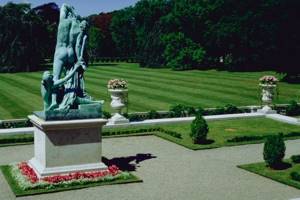
Parterre lawns (link to article) in French regular style gardens should be covered with an even, silky and thick grass cover, reminiscent of a soft fleecy carpet. This surface is created by low narrow-leaved grasses - red fescue, meadow grass, bentgrass. Either one type of grass is sown, or a mixture of two different types capable of forming a homogeneous grass stand. You will have to cut it up to twice a week so that the grass does not grow higher than 1 cm.
When arranging parterre flower beds and regular arabesque flower beds, flowers must be selected so as to ensure continuous flowering throughout the season. In early spring, bulbous plants - narcissus, tulip, crocus, scylla, as well as early flowering perennials - for example, liverwort and anemone will be appropriate for them. Flowers for summer: viola, daisy, aquilegia, iris, alyssum, marigold, calendula, petunia, salvia, and many others. In autumn, the splendor of regular flower beds and flower beds will be emphasized by roses, helenium, asters and dahlias.
Trees, flowers and shades of regular parks
North parterre of the Versailles Park
Decorative flowers were extremely rare in French gardens of the 17th century, and the range of their color shades was small: blue, pink, white and purple. Brighter shades (yellow, red, orange) appeared only after 1730, when world achievements in the field of botany became available in Europe. Tulip bulbs and other exotic flowers came from Turkey and Holland. A very important decorative element in Versailles and other gardens was topiary, a tree or bush that was cut into a geometric or grotesque shape. Topiaries were placed in rows along the main axis of the garden, alternating them with vases and sculptures. At Versailles, flower beds were arranged only in the Trianon and in the North Parterre directly next to the palace (the windows of the Great Royal Apartments face the North Parterre). Flowers were usually brought from Provence, kept in pots and changed 3 or 4 times a year. The financial statements of Versailles for 1686 show that 20,050 yellow jonquil bulbs, 23,000 cyclamen and 1,700 lilies were used in the gardens.
Most of the trees at Versailles were moved from the forests; hornbeams, elms, lindens and beeches were used. Chestnuts brought from Turkey and acacia also grew there. Mature large trees were dug up from the forests of Compiegne and Artois and replanted in Versailles. Many trees died after transplantation and were replaced regularly.
The trees in the park were trimmed horizontally and aligned at the tops, giving them the desired geometric shape. It was only in the 18th century that trees were allowed to grow naturally.
Small architectural forms in a regular style
In the French style, bulky and massive furniture is inappropriate. There are only two options for selecting household items - elegant, light products with elegant forged legs and supports, light seats, or typical furniture in the style of street cafes and summer terraces of restaurants.
But gazebos, if the area is large enough to install them, especially light structures in a romantic style, are welcome. In addition to those allocated in the basic structure, be sure to use each area in the garden, be it an extension, the intersection of paths or their “blind” end, for arranging zones and corners for relaxation.
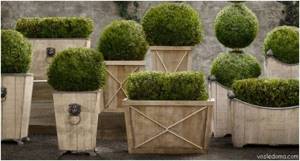
A special place in the aristocratic French style should be given to potted gardens. If in the Mediterranean style they are simply displayed on platforms, then the French style is more inventive. He suggests using ladders or original multi-level supports for potted displays, which will simultaneously make the most of the space and emphasize the thematic design. Typical plants for the French potted garden are geraniums. A collection of different varieties on the steps of a staircase or even on a stepladder installed in a corner near the terrace is real French “chic”. For potted gardens, only white and pink flowering plants can be used.
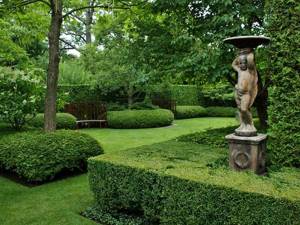
Several potted plants should definitely be installed in the recreation area. They should be on the table, next to every piece of furniture, under seats and table tops. True, you should not use individual plants planted in pots, but entire potted compositions. What kind of flower pots will be is not so important, but light and non-glossy materials are better suited for the French style; in particular, clay vessels are considered typical. Roses, boxwoods, olive trees, laurel, citrus fruits, pomegranate, and lantana can be used as potted plants.
In such a garden, you simply must install at least one classic garden sculpture, reminiscent of French castles and palaces. If you have a high wall in your garden, then install a large mirror on it or create a wall landscape with perspective, camouflaging the sides with climbing plants. Such a spectacular “reflection” or unexpected perspective will bring a feeling of spaciousness and peace to the garden.
Unjust condemnation of Baroque gardens
Theorists of landscape gardening later talked a lot about the anti-feudal, rather than monarchical, essence of a landscape park. Active, often aggressive planning geometry and active interference in the development and growth of bushes and trees were blamed on Baroque gardens. It was completely forgotten that the regular park was monopolized by royalty in 17th century France. It was from France that the fashion for conquering nature in the garden came - for the king, the nobleman, and man in general. But a regular park arose in Italy at a time when the institution of absolutism, personified in the office of the king, was established. Therefore, the regular park was not guilty of crimes of royal (absolute) power.
Part of the savior of small gardens with a regular layout was even Humphrey Repton (1752-1818), better known as the theorist and practitioner of landscape gardening in England. On the palazzo territory, Humphrey Repton left a terrace, balustrades, flower beds, and a regular layout - signs of Baroque in the landscape environment of an English park. Elements of a regular layout without the gigantomania of Versailles have taken pride of place in recent times in the development of parks near sports areas in the 20th century.
The spirit of anti-feudal freedom of English gardens was extended only to the planning of gardens and the refusal to trim trees. From the first years of its existence, the English garden began to serve the absolute power in the same Britain of the 18th century as actively as the French park in Versailles of the 17th. The vicious circle has closed.
But this was carefully ignored neither in liberal Britain, nor in royal France, nor in the Russian Empire, nor in the German principalities and the like.
French style ponds
An important element of the classic style is water. It is embodied in pools with fountains, cascades and wall fountains. The mirror surface of the water will fit perfectly with the overall composition. The pond on the site is made in the shape of a circle, oval, square, rectangle. The coastline must be clear; plants in the coastal zone are planted in strict order, in rows. On large areas, cascades are often created - multi-stage structures made of stone or concrete that serve to cascade streams of water. Fountains are also installed on the site, which can serve as the center of flower arrangements, for example. Here, too, everything is subject to the laws of geometry: reservoirs have a strictly symmetrical, most often rectangular shape.
|
|
Garden as a manifestation of architecture
Corner of the park at Hampton Court, London
Organizers of regular style gardens considered their work a kind of work of an architect, expanding the space of a building beyond its walls and arranging nature in accordance with the laws of geometry, optics and perspective. Gardens were created like buildings, with a suite of rooms through which the viewer passed, following a given route, with corridors and lobbies. In their drawings they used the terminology of architects; the sites were called halls
,
rooms
and green
theaters
.
The “walls” were made using trimmed bushes, and the “stairs” using water. blankets
on the ground , decorated with plants, and trees formed
curtains
along the alleys.
Like the architects who designed water systems for chateau buildings, landscape architects designed hydraulic systems to supply water to garden fountains and ponds. Large pools filled with water replaced mirrors, and jets of water from fountains replaced candelabra. In the bosquet "Backwater"
of the gardens of Versailles, Andre Le Nôtre placed tables of white and red marble on which to serve food. Flowing water in pools and fountains imitated the filling of jugs and crystal glasses. The dominance of architecture in gardens existed until the 18th century, when English landscape parks came to Europe, and romantic painting instead of architecture began to serve as a source of inspiration for the design of gardens.
Materials and decorative elements in a regular style
The materials for a regular garden are chosen to be expensive, high quality - valuable wood, marble, ceramics, bronze. Accessories for a regular garden should also look rich, there should not be too many of them, but they should all favorably emphasize other elements of the garden and be “in place.” When decorating gazebos, wood carving and artistic forging are usually used. Fencing in a formal garden is cast iron or cast with a classic lattice pattern. In a formal garden, preference is given to calm tones, classic ornaments, and plant motifs.
Features of landscape style
To create a garden with a natural landscape, you need a plot of at least 12-14 acres. A small garden will not be able to fully convey a full-fledged harmonious picture and will only accommodate fragments of the landscape style.
The garden should look natural, but this does not mean neglected and unkempt plants. Approaching maximum naturalness, the natural style organizes the shapes of paths, the location of ponds and gazebos.
You can create a garden in a landscape style both on hilly areas and on plains. The choice of plants will be different, but the basic principles of garden design will be the same:
- Smooth lines. Natural style does not tolerate straight lines, sharp angles and symmetry. The paths should be winding and asymmetrical. The banks of reservoirs do not have to be perfectly smooth.
- Natural materials in decoration. We give preference to wood and stone. You can use clay statues and forged lamps. Modern plastic decorations and figures will not fit into natural design.
- Recognizable plants. The garden should be filled with those plants and shrubs that are characteristic of the area. It is not recommended to use exotic flowers and unknown herbs.
- Calm color scheme. The beauty of the landscape is emphasized by calm colors. These are green, purple, white, pale pink, silver. The natural landscape does not need to be artificially decorated with variegated flowers, which will introduce an unnatural riot of colors and flashy shades.
- Free plant growth. Of course, the bushes need to be trimmed, the lawns mowed, and the flowers thinned out. But there is no need for figurative modeling of plants or creating artificial topiaries.
No. 10. Forest style
The forest style is reminiscent of eco-style in that it involves minimal intrusion into the natural landscape. All efforts come down to connecting the house with the surrounding nature and only placing some accents without disturbing nature or making global redevelopments.
Main features:
- ideal for areas located in forested areas. Only in this case will it be possible to fulfill the main requirement of the style - naturalness and naturalness. The size of the territory does not matter;
- all forms in the garden should resemble natural ones, zoning is also carried out along natural lines;
- Only natural colors are used, inclusions of bright colors are minimal;
- All materials are natural, wood comes first. Paths can be created using gravel, wood cuts, grass or bark. Paving is used to a minimum, and only the main path leading to the house may have a noticeable curb;
- plants – all forest species that grow in the region. All forest shrubs are used together with them; vertical gardening is allowed. Chamomiles, cereals, buttercups, bells, and medicinal plants will fit perfectly into the style. An excellent decoration is flower beds in stumps and logs;
- you can arrange gazebo-houses on the site. Garden furniture is simple, wooden, varnished. Hammocks and swings will fit into the forest style; driftwood and wooden figurines can be used as decoration. Ponds and streams are welcome.
When arranging your site, you can combine similar styles, but this must be done very carefully. It is allowed to use elements of the chosen style to organize only part of the garden area. In any case, all work on the landscape design of a country or summer cottage must be preceded by careful planning, without which it is impossible to create a harmonious and integral territory.
The article was written for the site remstroiblog.ru.
No. 2. English style (landscape)
The style presupposes complete naturalness and the absence of strict forms, the rejection of geometrically correct figures and complete fusion with the surrounding nature. It recreates the atmosphere of noble estates of the 19th century, imbued with romance. The style involves reasonable intervention in nature and consideration of regional vegetation - the work of human hands to improve the site should not stand out, as is the case with the regular style.
Main features:
- winding paths, naturally shaped ponds, a seeming lack of order. However, an English-style plot will require the same constant and careful care as any other, and the lawn, the most important element of the style, should always be trimmed and maintained in a neat manner;
- the landscape style can be fully recreated on fairly spacious plots of at least 12 acres. Owners of more modest territories will be able to arrange only some part of their site in the English style;
- the predominant color is green in all shades, silver;
- In addition to the lawn, vertical gardening is often used, and part of the fence or the facade of the house can be covered with vines. English-style plots are literally buried in flowers; you can use hollyhocks, roses, pansies, as well as tulips, crocuses and daffodils. It is advisable to plant flowers in groups and make lush compositions. Be sure to use juniper, thuja or boxwood; decorative willow, elderberry, and jasmine are also suitable;
- paths are made only from natural materials: stone, tree cuts. The decoration of the site will be a small pond with water lilies or lilies, a bridge over a pond, benches made of natural materials, as well as gazebos, arches and trellises entwined with plants, and ancient objects.
Landscape design and its styles
English
English, also known as natural, landscape style presupposes careless naturalness in everything. Ornate paths, meadow grasses, slightly overgrown ponds - everything should look as if it has not undergone any special care. Of course, this is not true. An exception to the general concept of lawns - neat lawns with benches along the paths are typical for England. This style fits well into our climatic conditions; the plots will look harmonious both in summer and winter. To decorate in the English style, it is almost mandatory to have secluded, shaded corners, ivy-covered gazebos, a pond with water lilies, and reeds. It must be remembered that such a style can only be completely recreated over a relatively large area. It will not be possible to do this on four hundred square meters.
Mediterranean
Mediterranean style is characterized by the widespread use of marble, pebbles, and stones in decoration. The nature of the origin of the style presupposes the presence of steps, retaining structures, stairs, and terraces. Garden plantings are interspersed with artificially created decorative elements. In cold climates, it is difficult to implement the idea of a Mediterranean garden, except perhaps in winter gardens. The Mediterranean style is characterized by an abundance of citrus fruits, palm trees, olives, and pistachios. From this garden topiaries came to us - skillfully trimmed bushes in the form of intricate figures. The furniture in such a garden is light and comfortable; the main decorative elements are copies of antique statues, amphoras, and pseudo-ancient vases. Such ceramics are often entwined with ivy. Fountains will not be superfluous, but they should not be too bulky; compact marble bowls will suffice.
French
Everything fits the line - the main idea of the French style. Clear lines, exceptionally regular shapes, perfectly smooth paths. The entire composition should be centered around a small pond or fountain - always of the correct geometric shape. A lawn is planted on a large area of the site, fenced with a thick hedge - bosquet. An interesting element is a labyrinth of densely planted trees, which are given the clear shape of a pyramid, ball, or cube. The walls of a living puzzle can have hidden niches with benches, as if you were in the gardens of Versailles. Fountains in the French style are characterized by an impeccably regular shape, but always massive with a spectacular release of jets of water. The paths are covered with fine gravel and outlined with neat plant borders. There are no random spots in the pattern of the flower beds; they are either simple to the point of disgrace, or they represent an intricate but clear pattern.
Oriental
Refined transitions, smoothness, unhurriedness in everything, gentle combinations characterize the oriental style. Dwarf trees and low-growing bushes interspersed with small ponds. The landscape is intended to relieve stress and leisurely reflection on the essence of existence. The colors are selected discreetly, softening the atmosphere. The key to everything is the stones - they should look as if they have lain in one place for thousands of years. Their shapes are round and covered with moss. They serve as a reminder of the fleeting nature of our lives compared to eternity. Narrow alleys and curved bridges encourage long, leisurely walks. Everything in the eastern garden is imbued with philosophy, especially little things in the form of lanterns and vases. Carps in a garden pond serve as a symbol of prosperity; they can easily withstand the harsh winter. The standard gazebo is replaced by a house for tea ceremonies.
Russian style
Close to us is the Russian style. Decorating the site is rustic, with a fairytale touch. Plantings are based on practicality - all kinds of fruit trees, flower beds consisting of medicinal herbs. Estates built in the Russian style are characterized by the presence of a bathhouse, a real, at worst, decorative well. Wooden gazebos, wicker fences decorated with antique clay pots, paths made of wooden circles are indispensable attributes of the style. Children will be delighted by the carved fairy-tale characters placed randomly throughout the site. A collection of antique household items will help enhance the atmosphere. The outer boundaries of the site are often lined with white-trunked birch trees. To bring to life the idea of decorating a plot in the Russian style, you don’t need much - remember your grandmother’s house in the village, bring warm childhood memories to life, modernizing them somewhat.
Garden as a manifestation of theater
In formal gardens
There were often staged plays, musical performances and fireworks displays. In 1664, Louis XIV staged a seven-day celebration in the renovated gardens of Versailles, complete with ceremonial passages, comedies, ballets and fireworks displays. In the gardens of Versailles there was a water theater decorated with fountains and statues of young gods (destroyed between 1770 and 1780). Full-size ships were built for cruises along the Grand Canal, and an open-air dance hall surrounded by trees was installed in the garden; a water organ, a special labyrinth and a grotto were also built.





